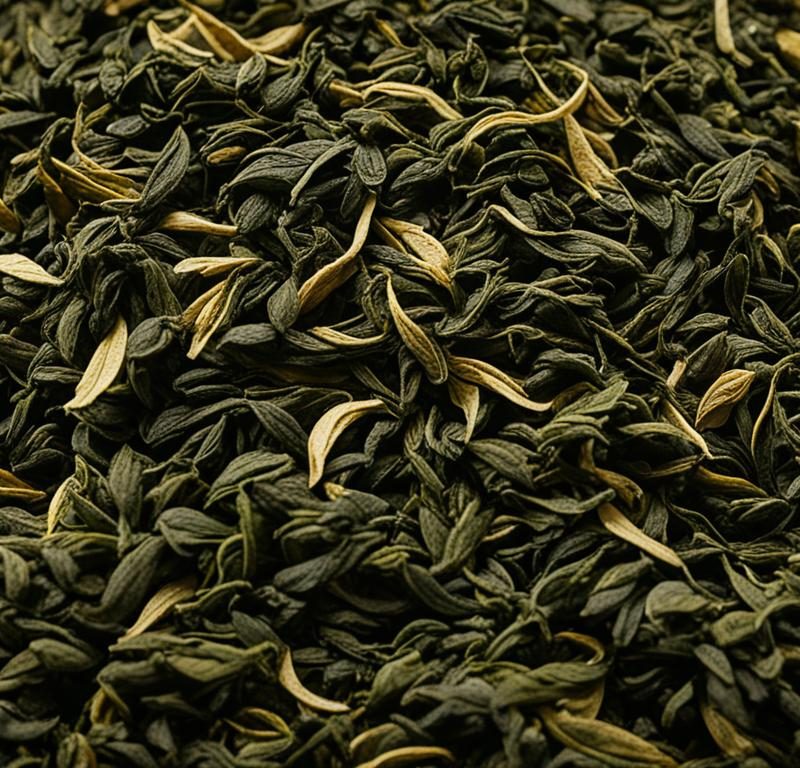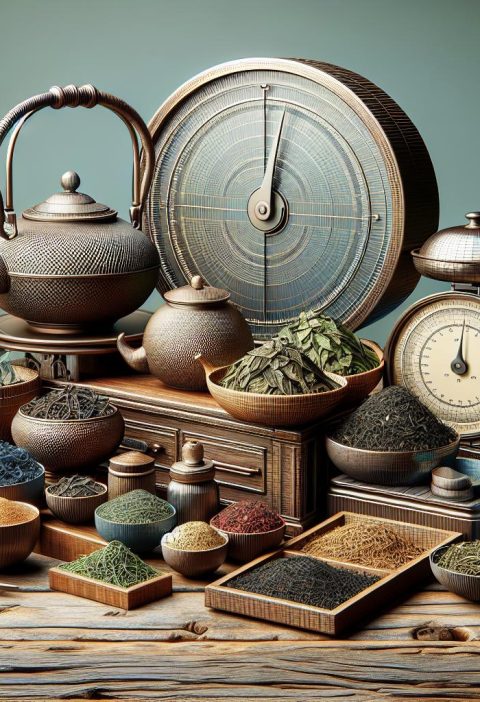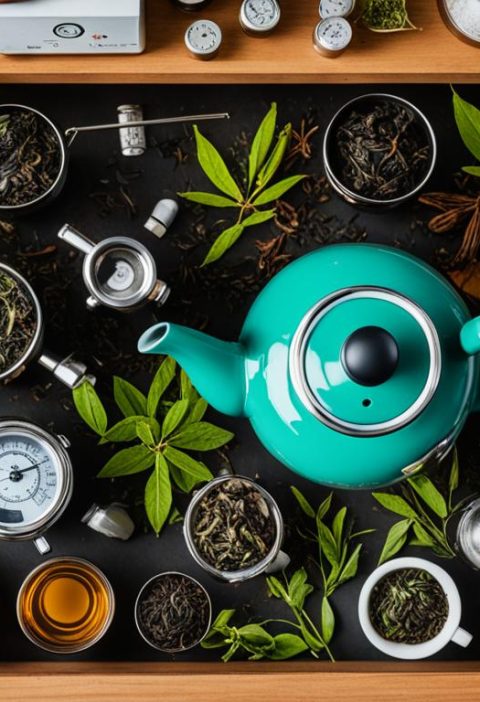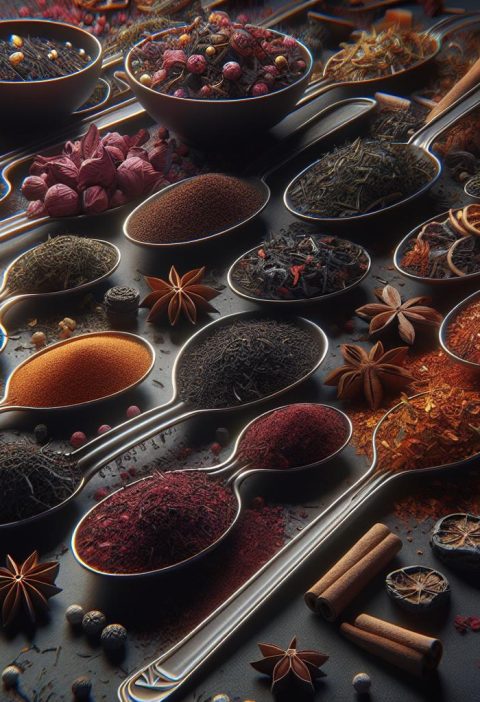As a tea enthusiast, I have always been fascinated by the world of Assam tea. Its robust flavor, exquisite aroma, and unique characteristics make it a true delight for the senses. That’s why I’m excited to share with you the art of exploring Assam tea tasting notes. From the malty flavor to the deep red hue, each sip offers a full-bodied experience that is sure to captivate your taste buds. Join me on this journey as we dive into the rich flavors and aromas of Assam tea.
Key Takeaways:
- Assam tea is known for its robust flavor and exquisite aroma.
- Each sip of Assam tea offers bold notes and a full-bodied experience.
- Assam tea is characterized by its malty flavor and deep red hue.
- Exploring Assam tea tasting notes allows you to discover the richness and beauty of India’s pride.
- Assam tea is a popular choice among tea enthusiasts worldwide.
The Unique Characteristics of Assam Tea
Assam tea, derived from the Camellia Sinensis Assamica variety, stands out with its distinct characteristics among other tea plants. The leaves of this variety are larger and thicker, contributing to the unique attributes of Assam tea. Let’s explore the exceptional features and qualities that make Assam tea a favorite among tea enthusiasts.
When brewed, high-quality Assam tea exhibits a bright, dark amber-red color that entices your senses. The liquor presents a fragrant aroma that combines notes of tobacco, malt, and honey, creating a delightful olfactory experience. These rustic and earthy undertones add depth to the overall tea-drinking experience.
As you take a sip, you’ll notice that Assam tea carries a slightly tannic flavor, which is characteristic of the variety. The tea leaves unleash a unique combination of flavors, including chestnut honey notes with occasional hints of citrus. This interplay of sweet, rich tones creates a balanced and enjoyable taste profile.
To ascertain the quality of Assam tea, a grading system is in place. This system evaluates the tea based on its overall quality, appearance, flavor, and aroma. Higher grades indicate superior taste and aroma, translating into a more exceptional tea experience. The grading system enables tea enthusiasts to make informed choices and select their preferred Assam teas based on their personal taste preferences.
Now, let’s take a closer look at the Assam tea grading system:
| Grade | Appearance | Characteristics |
|---|---|---|
| TGFOP | Thin and wiry leaves with golden tips | Full-bodied with a malty flavor |
| FTGFOP | Leafy with golden tips | Complex flavor and pronounced maltiness |
| FTGBOP | Bigger leaves with golden tips | Deep and bold flavor with a strong malty note |
Now that we have explored the fascinating characteristics of Assam tea, it’s time to delve into its brewing tips and unleash the full potential of this remarkable brew. But before that, let’s indulge our eyes with an enticing image of Assam tea leaves:
Join us in the next section to discover the art of brewing Assam tea to perfection.
Brewing Tips for Assam Tea
When it comes to preparing the perfect cup of Assam tea, following the right brewing techniques can make all the difference. Here are some valuable tips to ensure you extract the full flavor and aroma from your Assam tea leaves:
- Water temperature: Use water heated to 95 degrees Celsius for optimal extraction of flavors. This temperature allows the tea leaves to infuse properly, resulting in a rich and satisfying brew.
- Steeping time: Steep your Assam tea leaves for approximately 4 minutes to achieve the desired strength and depth of flavor. Adjust the steeping time according to your preference for a stronger or milder brew.
- Tea leaf quantity: Use between 4 and 5 grams of loose Assam tea per cup. If you’re brewing in a larger teapot, add a few extra grams to account for the increased volume. This ensures a well-balanced and robust cup of tea.
- Milk or lemon: Assam tea pairs wonderfully with milk or lemon slices. The addition of milk creates a smooth and creamy texture, while lemon adds a refreshing tang. Experiment to find your preferred combination.
- Sweeten to taste: Assam tea can be enjoyed plain or sweetened to your liking. To fully appreciate the natural flavors, it is recommended to try it without any additional sweeteners before deciding whether to add sugar, honey, or other sweeteners.
By following these brewing tips, you’ll be able to unlock the true potential of Assam tea and enjoy a truly delightful tea experience.
| Water Temperature | 95°C |
|---|---|
| Steeping Time | 4 minutes |
| Tea Leaf Quantity | 4-5 grams per cup |
| Pairings | Milk or lemon |
| Sweetening | To taste |
The Aroma of Assam Tea
Assam tea, renowned for its robust flavor and exceptional aroma, delights tea connoisseurs with its distinctive fragrance. The aroma of Assam tea is both captivating and invigorating, offering a sensory experience like no other.
When brewed, Assam tea releases a rich, fragrant scent that can vary in nuances. Some batches of Assam tea exude a sweet and alluring aroma reminiscent of fresh jasmine flowers, while others boast a complex blend of spicy and fruity notes. The aroma unfolds gracefully, beckoning you to indulge in its natural allure.
One can enjoy the aroma of Assam tea on its own or pair it with complementary flavors. The choice is yours, and the possibilities are endless.
Assam Tea Pairing Suggestions
The aromatic qualities of Assam tea make it an excellent accompaniment to a range of delectable treats. Here are some pairing suggestions to elevate your tea-drinking experience:
- Assam tea pairs harmoniously with creamy milk or cream, enhancing its smoothness and balancing its robust character.
- For a delightful morning ritual, complement the aroma of Assam tea with freshly baked biscuits or scones, creating a perfect combination of fragrance and flavor.
- Indulge in the sweet pleasure of pairing Assam tea with rich, buttery cakes, accentuating both the tea’s aroma and the confection’s irresistible sweetness.
- For an afternoon treat, savor Assam tea alongside an array of sweets, such as pastries, cookies, or macarons, creating a symphony of flavors on your palate.
No matter what you choose, the aromatic experience of Assam tea will captivate your senses and elevate your tea-drinking moments.
| Assam Tea Aroma | Pairing Suggestions |
|---|---|
| Sweet and alluring aroma resembling fresh jasmine flowers | Creamy milk or cream |
| Complex blend of spicy and fruity notes | Freshly baked biscuits or scones |
| Rich, buttery cakes | |
| Pastries, cookies, or macarons |
The History and Significance of Assam Tea
Assam tea has a rich history that dates back to the time of the British East India Company. The fertile lands of Assam in India were ideal for tea production, and the British East India Company played a significant role in the establishment of the tea industry in the region.
The production of high-quality Assam tea became famous during this period, making it an integral part of Assam’s heritage and culture.
The Influence of the British East India Company
The British East India Company recognized the potential of Assam’s tea-growing environment and initiated large-scale tea production in the region. They brought in experts and implemented cultivation techniques to maximize tea yields. The company played a crucial role in introducing Assam tea to the international market, leading to its global popularity.
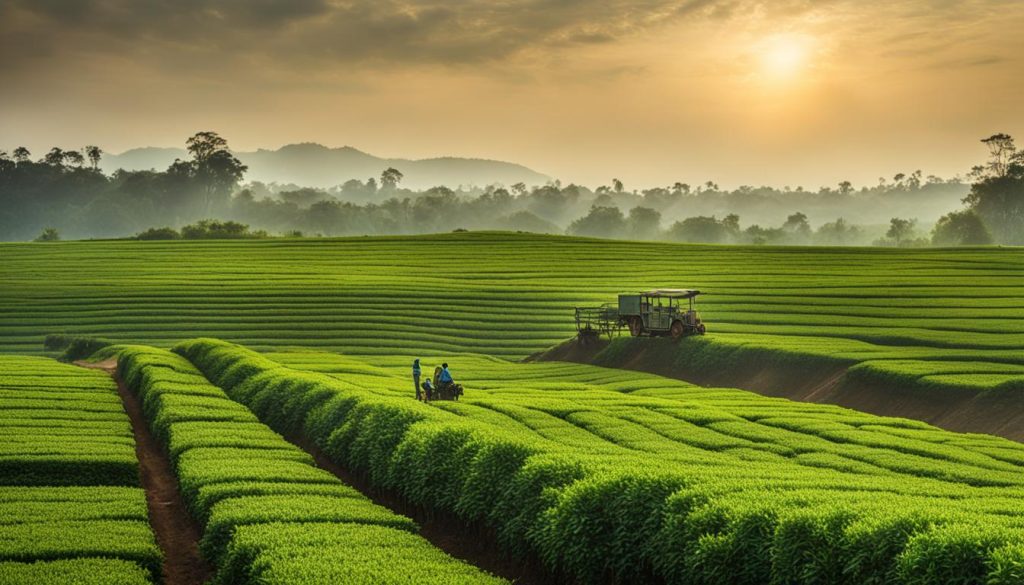
Assam Tea: A Cultural Icon
Today, Assam tea remains an integral part of Assamese culture and identity. The tea estates of Assam have become iconic landmarks, preserving the legacy of tea cultivation and showcasing the region’s extraordinary natural beauty.
Assam Tea Production: A Work of Art
Assam tea production is a meticulous process that requires skill and expertise. From cultivating the tea plants to harvesting, processing, and packaging the leaves, every step is carefully executed to ensure the exceptional quality for which Assam tea is known.
| Assam Tea Production Steps | Key Highlights |
|---|---|
| 1. Plantation | Tea bushes are cultivated in the fertile soil of Assam, benefiting from the region’s abundant rainfall. |
| 2. Plucking | Skilled tea pluckers carefully handpick the young, tender leaves that are rich in flavor. |
| 3. Withering | The freshly plucked leaves are spread out to wither, reducing their moisture content and preparing them for further processing. |
| 4. Rolling | The withered leaves are rolled to release enzymes, kickstarting oxidation, and bringing out the characteristic flavors. |
| 5. Fermentation | The rolled leaves are left to ferment, a crucial step that enhances the tea’s flavor profile. |
| 6. Drying | The fermented leaves are carefully dried to halt oxidation, preserving the flavors and aromas. |
| 7. Sorting & Packaging | The dried leaves are sorted based on their size and appearance, packaged, and prepared for distribution. |
Each batch of Assam tea is a testament to the region’s centuries-long tea-making expertise and the dedication of the tea workers who continue to uphold this proud tradition.
Kanoka Rolled Assam Tea: A Masterpiece of Flavor
Kanoka Rolled Assam Tea, crafted at the Kanoka Tea Estate in Assam, is a shining example of Assam tea craftsmanship. The tea leaves used for Kanoka Rolled Assam Tea are meticulously handpicked and skillfully handcrafted to create a tea with exceptional flavor and aroma. Each step of the process, from plucking to rolling, is carried out with utmost care and precision, ensuring that every cup of Kanoka Rolled Assam Tea delivers a delightful and immersive tea-drinking experience.
This artisanal tea captures the essence of Assam tea flavor, showcasing the region’s unique terroir and the expertise of the tea artisans. The flavor profile of Kanoka Rolled Assam Tea is characterized by rich maltiness and subtle woodiness, accompanied by underlying notes of sweet honey and fig. Each sip reveals a harmonious balance of flavors, leaving a lingering and satisfying aftertaste.
Unlike machine-processed teas, Kanoka Rolled Assam Tea undergoes a specialized rolling technique that helps release the tea’s natural oils, intensifying its flavor and fragrance. This artisanal approach enhances the overall quality and complexity of the tea, making it a standout choice for tea enthusiasts who seek an exceptional tea-drinking experience.
Kanoka Rolled Assam Tea Flavor Profile
| Characteristic | Flavor |
|---|---|
| Maltiness | Rich and robust |
| Woodiness | Subtle and earthy |
| Honey | Sweet and lingering |
| Fig | Delicate and fruity |
Experience the mastery of Assam tea craftsmanship with Kanoka Rolled Assam Tea. Each cup is a testament to the dedication and skill of the tea artisans, offering a unique and captivating tea-drinking experience. Indulge in the robust flavors and captivating aroma of Kanoka Rolled Assam Tea, and let it transport you to the lush tea gardens of Assam.
Brewing Perfection with Kanoka Rolled Assam Tea
To fully appreciate the nuances of Kanoka Rolled Assam Tea, it is recommended to enjoy it without milk. The leaves unfurl their full complexity, allowing you to explore the layers of flavor with each sip. This tea can be brewed multiple times, with each steeping extracting its exceptional taste. By choosing Kanoka Rolled Assam Tea, you not only indulge in a premium tea experience but also support fair trade and sustainable tea cultivation practices.
When brewing Kanoka Rolled Assam Tea, follow these recommendations to ensure a delightful and satisfying cup:
- Start with fresh, cold water and bring it to a boil.
- Measure the desired amount of tea leaves. We recommend using 2 grams of tea per 8 ounces of water.
- Place the tea leaves in a teapot or tea infuser.
- Pour the hot water over the leaves and let them steep for 3 minutes.
- For subsequent brews, increase the steeping time by 1-2 minutes to extract even more flavor.
- Enjoy the rich aroma and exquisite taste of Kanoka Rolled Assam Tea.
Kanoka Rolled Assam Tea can be re-steeped multiple times, revealing new flavors and subtleties with each brew. Experiment with different steeping times and discover your preferred strength and taste profile. Remember to adjust the brewing parameters to your personal preference.
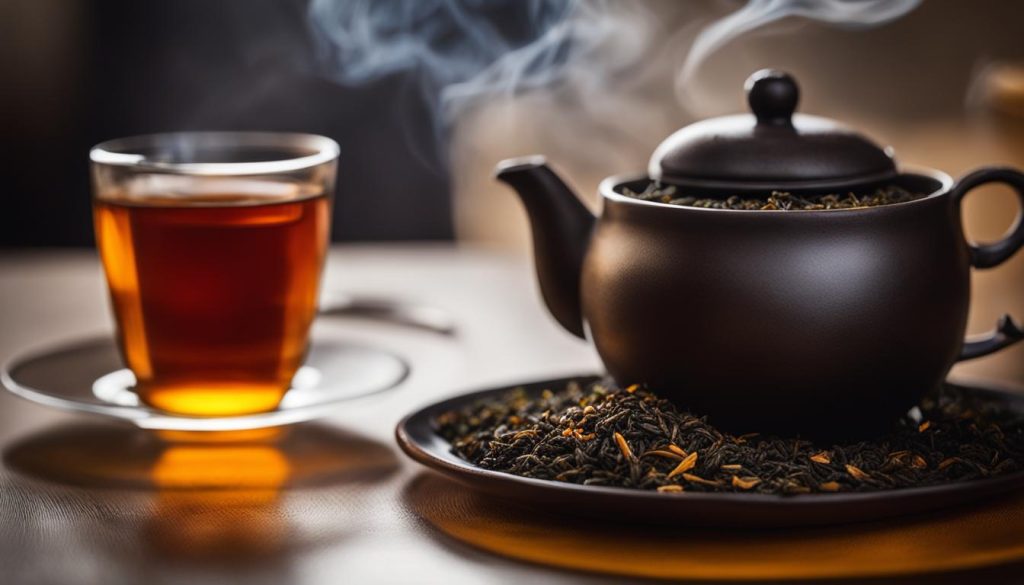
Assam Tea’s Contribution to Indian Tea Production
Assam tea plays a significant role in Indian tea production. The region of Assam, with its fertile soil and favorable climate, produces a large quantity of tea that contributes to India’s tea industry. Assam tea is known for its distinct flavor and characteristics, making it a popular choice among tea drinkers worldwide. Its production supports the livelihoods of tea workers and small family growers in Assam, contributing to the economic development of the region.
Conclusion
Exploring Assam Tea Tasting Notes allows you to dive into the world of flavors and aromas that this exquisite tea has to offer. Assam tea, with its robust and malty character, offers a unique tea-drinking experience that captivates the senses. The fragrant and diverse aroma of Assam tea adds another layer of pleasure to your tea sipping experience.
Whether you prefer your Assam tea pure or with a splash of milk, the rich and distinct flavors are sure to delight your taste buds. Each sip carries the essence of India’s pride, transporting you to the lush tea estates of Assam. As you savor the nuances of Assam tea, you’ll discover the richness and beauty of this beloved beverage.
So, take a moment to indulge in an exceptional tea experience. Explore the captivating flavors and fragrances of Assam tea. Whether it’s a morning ritual or an afternoon relaxation, let Assam tea transport you to the enchanting world of tea tastings.
